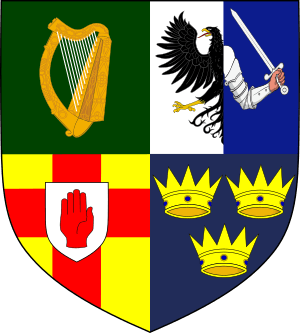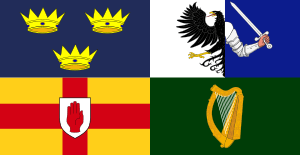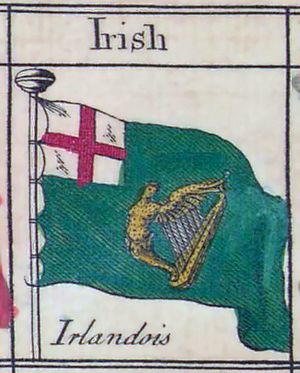Coat of arms of Ireland facts for kids
Quick facts for kids Coat of arms of Ireland |
|
|---|---|
 |
|
| Versions | |

The banner of arms, which serves as presidential standard
|
|
| Armiger | Republic of Ireland |
| Adopted | 1945 (registered: Arms of Ireland) c.1541 (recorded: Kingdom of Ireland), c.1280 (recorded: King of Ireland) |
| Blazon | Azure a harp Or, stringed argent (Irish: Ar ghorm cláirseach órga na sreanga airgidí) |
| Earlier version(s) |  |
| Use | The harp is used on all Acts of Oireachtas; the seal of the President; the cover of Irish passports; various government departments; the obverse of Irish euro coins. It is also used in the United Kingdom, where it appears in the lower-left quadrant of the royal coat of arms of the United Kingdom and is incorporated as a badge into devices used by official bodies in Northern Ireland. |
The coat of arms of Ireland is a special symbol for the country. It shows a gold harp with silver strings on a blue background. This design has been a key symbol for Ireland for a very long time.
People started using the harp as a symbol for the "king of Ireland" as early as the 1200s. Later, in 1541, Henry VIII made Ireland a kingdom again and officially adopted the harp as its symbol. When Ireland, England, and Scotland joined under one ruler in 1603, the harp became part of the larger royal coat of arms.
In 1922, when the Irish Free State became independent from the United Kingdom, the harp was chosen as its national emblem. It was officially registered as the arms of Ireland in 1945. The way the harp looks has changed over the years. The modern design is based on a famous old Irish harp called the Trinity College Harp.
There are also other versions of Ireland's arms, like a special badge. For a long time, before the harp, Ireland had different arms. These showed three gold crowns on a blue background with a white border.
Contents
What is the History of Ireland's Coat of Arms?
The idea of using coats of arms became popular in Europe around the 1100s. In Ireland, these symbols started appearing after the Norman invasion of Ireland in 1169. The first official person in charge of coats of arms for Ireland was mentioned in 1392.
Even before it was officially adopted, the harp was linked to the "King of Ireland." An old French book of arms from around 1280 shows a gold harp on a blue background for the King of Ireland. This idea might have come from old stories or poems.
The harp officially became the symbol of the new Kingdom of Ireland in 1541, thanks to Henry VIII. It was then added to the royal arms of England, Ireland, and Scotland when their crowns united in 1603. When the Irish Free State became independent in 1922, the harp was chosen as the symbol for the new Irish state.
Today, you can see the harp on Irish coins, passports, and official government seals. It's also used by many groups in Northern Ireland and by Irish companies like Guinness and Ryanair. Countries with historical ties to Ireland, like Montserrat and Canada, also feature the harp in their symbols.
The President's Special Flag
Since 1945, the harp has also been the special symbol for the President of Ireland. The President uses a flag called the Presidential Standard, which shows the harp. This flag flies over the President's home, Áras an Uachtaráin, and on cars used by the President.
Like other special flags for leaders, it is never flown at half-mast (a sign of mourning). However, the President's flag does not take priority over the main flag of Ireland.
Older Symbols of Ireland
Before the harp, the Lordship of Ireland, which was under English rule from 1171 to 1541, had different arms. These arms showed three golden crowns placed one above the other on a blue background with a white border.
These three crowns were a symbol of Edmund the Martyr, a saint. Irish lords fighting in wars in the 1300s used them as their banner. It's thought that these three crowns were stopped as Ireland's symbol after Henry VIII broke away from the Pope. The Pope's special hat, the Papal Tiara, also has three crowns, and some thought the old arms might suggest the Pope had power over Ireland.
Even after the harp became the main symbol, some old coins and maps from the 1500s still showed three harps instead of three crowns. However, the single harp quickly became the most popular symbol.
Another old symbol sometimes used for Ireland was from the royal province of Meath. This showed a king sitting on a throne.
What Does the Harp Look Like?

The modern design of the harp used by Ireland today is based on the famous Brian Boru harp, which is a very old Irish harp. This design was created by an English artist named Percy Metcalfe for Irish coins in the 1920s. His design became the official look for the harp as a state symbol.
In the past, especially in the 1600s, the harp was sometimes drawn with a woman's head and chest as part of its front pillar. The official design today doesn't have this.
The harp always has gold strings and is always gold in color. It is shown on a blue background. This blue color is sometimes called St. Patrick's blue. The use of blue might be linked to an old Irish mythical figure named Gormfhlaith, which means "blue sovereign." In old Irish stories, the spirit of Ireland was often shown as a woman in a blue robe.
Ireland's coat of arms does not have animal supporters (like lions or unicorns) or a special motto. While some old drawings might show them, these were usually artistic choices, not official parts of the symbol.
The Green Flag of Ireland
Besides the blue flag with the harp, Ireland has also been linked to a green flag with a gold harp. This flag is exactly like the coat of arms, but with a green background instead of blue.
The earliest known record of this green flag is from the 1600s. An Irish soldier named Eoghan Ruadh Ó Néill flew it on his ship. This green flag was also used by Irish rebels in the 1798 Rebellion and by Irish soldiers fighting in other countries, like in the American Civil War.
Even though the Kingdom of Ireland never had an official flag, this green flag was often seen as the flag of Ireland in the 1700s and 1800s. It is very similar to the flag of the province of Leinster. Many believe that Leinster's flag came from this older green flag of Ireland.
Symbols of the Four Provinces


The symbols of Ireland's four traditional provinces are often shown together as a popular symbol for all of Ireland. These provinces are Leinster, Connacht, Ulster, and Munster. They are usually arranged in a specific order, like a checkerboard. This combined symbol is often seen on flags.
- The arms of Leinster show a gold harp on a green background. This is thought to have come from the main arms of Ireland, just with a different background color.
- Munster's arms show three old-style gold crowns on a blue background. These might have come from the older "three crowns" symbol of the Lordship of Ireland.
- The arms of Ulster combine the symbol of the de Burgh family (a red cross on gold) with the famous red hand of the O'Neill family.
- Finally, Connacht's arms show half an eagle and an arm holding a sword. These are believed to have come from an old Irish monastery in Germany.
See also
 In Spanish: Escudo de Irlanda para niños
In Spanish: Escudo de Irlanda para niños




